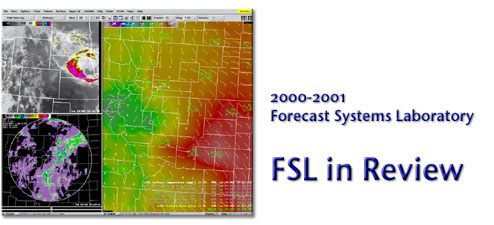|
|


Introduction
|
|

Message from the DirectorA. E. "Sandy" MacDonald, DirectorThe mission of the Forecast Systems Laboratory (FSL) is to transfer advances in science and technology to the nation's operational weather services. We believe that if we are doing our job well, a visit to FSL today will acquaint you with the systems and technologies that will be going into operational weather services 5 to 15 years in the future. Thus this annual report can be regarded as a time machine - think of it as a visit to the National Weather Service (NWS) of 2010. If we are successful in our efforts, how will the things we talk about here affect the operational weather services of 2010? Local Forecast Offices - This year, FSL played a major role in bringing AWIPS to full operational capabilities with its work on build 5. It also developed and demonstrated a PC/Linux version of the AWIPS workstation, and studied the longer term evolution of the AWIPS system. NWS's strategic plans to improve warnings and forecasts will require advances in processors, disk storage, local- and wide-area networks, and national data infrastructure and dissemination systems. With proper technology infusion, the local weather office of 2010 will have an AWIPS that looks outwardly much like today’s, but with capabilities far more sophisticated. New system concepts, such as the FX-Net, WorldWide Weather Workstation (W4), and FX-Collaborate, are discussed in this report. Advances in weather warning support, better dissemination, and graphical forecast editing are among the big differences that we hope to see infused into operational weather services in the coming years. National Observing System - We discuss recent successes in the reliability of the NOAA Profiler Network (NPN). We also present the growing national network of GPS receivers and how this technology is being used to improve weather prediction. Our satellite activities have emphasized the use of sounder data to improve local and regional models. The national network of 2010 could be a combination of a national profiler network, a fleet of aircraft with humidity as well as wind and temperature sensors, a ground-based GPS network of high density, effective use of national radar volume data, and geostationary interferometer sounder data in clear air. Such a network could approach the equivalent of having a radiosonde sounding on a 40-km grid over the entire United States every hour. Global Observing System - FSL researchers in the GAINS program are studying in situ platforms such as directable balloons and autonomous aircraft for use in global in situ observing. FSL will be working as part of the Joint Center for Satellite Data Assimilation to effectively use an array of exciting new satellite observing systems being developed and tested. The global prediction models of 2010 should have a mix of satellite observations giving excellent horizontal coverage, complemented by routine and adaptive in situ systems that produce highly detailed vertical soundings. The combination should be optimized for the global weather prediction system, and for diagnosis of climate change. Modeling and Assimilation - Our recent success in porting the Rapid Update Cycle (RUC) model from 40-km resolution to 20-km resolution along with other improvements is summarized . We also present exciting new advances in diagnosis of water in all phases, and the ability to do a "hot start" with our Local Analysis and Prediction System (LAPS) models. FSL is playing a major role in the development of the new Weather Research and Forecast (WRF) model, which could be operational at resolutions as small as a couple of kilometers over storm areas in 2010. Ensembles of high-resolution models with advanced assimilation and the national observing system discussed above could greatly improve explicit prediction of hazardous weather by 2010. Recent advances in air quality prediction, discussed in this report, could lead to much improved operational air quality prediction. High-Performance Computing - FSL’s Jet supercomputer was upgraded from 270 processors to 540 processors this year. We are running a variety of mesoscale models and observing system simulations, and are supporting other users such as ocean modelers. The Scalable Modeling System (SMS) is maturing, with improvements in its I/O and preprocessing. The supercomputers of 2010 should run at speeds of 50 trillion calculations per second and consist of thousands of processors. These computers could couple the ocean and land surfaces to the atmosphere, allowing predictability beyond the chaotic limit of a couple of weeks. Although we do not have a time machine to take us to 2010, the efforts you read about in this annual report should tell a lot about the operational weather services of the future.
|
|
